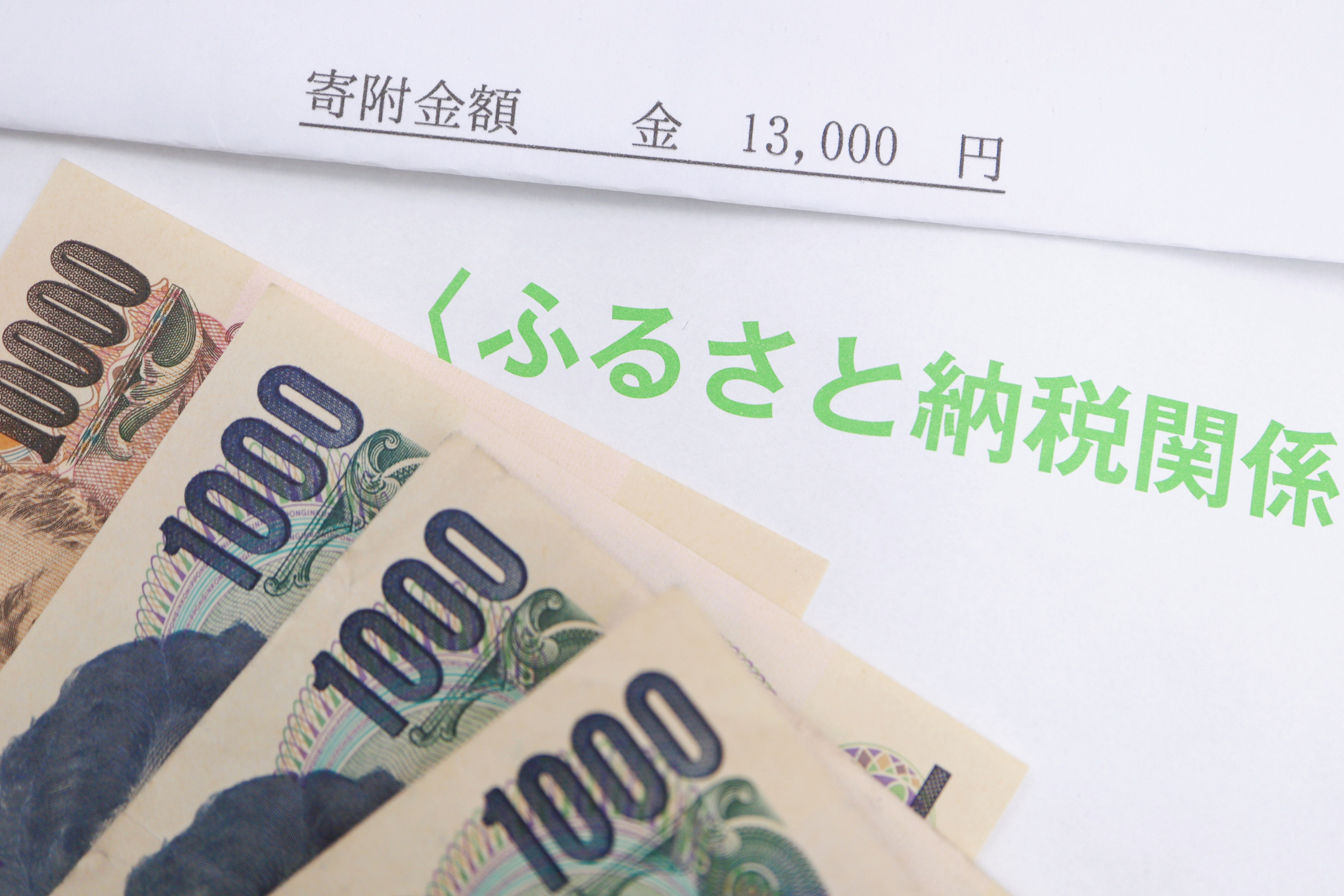
Growing Distortions in the Hometown Tax Scheme (2): The Pros and Cons of Private Sector Involvement
June 24, 2024
R-2023-104E
Introduction
On November 17, 2023, an intriguing joint declaration related to the hometown tax scheme was adopted: "Joint Declaration for Returning Hometown Tax Donations to Local Communities and Aiming for Further Healthy Development[1].” This declaration was issued by the United Local Governments for Ethical Development of the Hometown Tax Donation System, comprising 66 municipalities, and the Hometown Tax Association, which includes 40 private companies including the companies operating intermediary websites[2]. Although the administration of the hometown tax scheme is the responsibility of municipalities, various operations are outsourced to private businesses[3]. Thus, both the municipalities and the Hometown Tax Association industry group jointly issued this statement.
The joint declaration outlines the following three goals:
○ Local municipalities will strive to reduce advertising costs through creative ideas, provide local products as return gifts in an active and appropriate manner, and ensure that donations remain within the local community.
○ Private businesses will work to further streamline various services and operations related to the hometown tax scheme, thereby reducing costs for local municipalities.
○ The coalition of municipalities and the Hometown Tax Association will deepen their collaboration and work towards the further healthy development of the hometown tax scheme.
Why is there such a strong commitment to cost reduction in these goals? This article will discuss the roles and challenges of the private businesses mentioned in the joint declaration.
Introduction of New Rules
It is clear that one reason for these goals is the introduction of the new "50% rule" starting in October 2023. As mentioned by Hirata (2023a), while a rule capping expenses at half of the donation amount had existed previously, there were many cases before October where the cap was actually exceeded (see Fig. 1)[4].
Figure 1 Examples of Expense Rates Before the Introduction of the New 50% Rule (Fiscal Year 2022)
|
Municipality (Rank by Inflow) |
New Rule (Old Rule) |
Source (Publication Date) |
|
Miyakonojo City, Miyazaki (1st) |
Less than 50% (46.7%) |
Nishinippon Shimbun (October 20, 2023) |
|
Nemuro City, Hokkaido (3rd) |
55.1% (49.9%) |
Hokkaido Shimbun (June 28, 2023) |
|
Shiranuka Town, Hokkaido (4th) |
55.3% (49.8%) |
Hokkaido Shimbun (October 15, 2023) |
|
Iizuka City, Fukuoka (8th) |
65.7% (49.8%) |
Nishinippon Shimbun (October 20, 2023) |
|
National Average |
55.6–59.6% (43.6%) |
Tokyo Shimbun (October 16, 2023) |
Note: The expense rates under the new rule (total expenses ÷ hometown tax amount) were calculated by applying the new rule to the fiscal 2022 expenses based on newspaper interviews due to the lack of official data. The expense rates under the old rule are based on the MIC' published data for fiscal 2022. The national average is an estimate by NTT DATA INSTITUTE OF MANAGEMENT CONSULTING, Inc. as reported by Tokyo Shimbun.
Source: Prepared by the author
The stricter regulations on expenses have placed municipalities in a challenging environment. The ratio of the return gift value to the donation amount (return gift ratio) is capped at 30% (the "30% rule"). However, with a return gift ratio of 10 or 20%, the attractiveness of the hometown tax as a return diminishes. Therefore, return gift ratios are mostly set between 25 and 30%. If the return gift ratio is set at 28%, then other expenses such as shipping, publicity, payment fees, and administrative costs must be kept to 22% or lower (= 50% - 28%) of the donation amount (see Fig. 2). According to statistics from the Ministry of Internal Affairs and Communications (MIC) for fiscal 2022, the nationwide average numbers of shipping costs, publicity costs, and payment fees are about 7%, 0.7%, and 2% of the hometown tax amount, respectively. This leaves 12.3% (= 22% - {7% + 0.7% + 2%}) for administrative costs, which include labor costs, fees paid to intermediary sites, and costs associated with document processing. The average commission fee for intermediary sites is said to be around 10%, making it difficult to stay within this limit.
Figure 2 Comparison of New and Old Rules Regarding Expenses
|
Expense Breakdown |
New Rule |
Old Rule |
|
Procurement of Return Gifts |
Cost of return gifts, entrance fees to public facilities when offered as return gifts |
|
|
Shipping of Return Gifts (Approx. 7%) |
Shipping and packaging costs for return gifts |
|
|
Public Relations (Approx. 0.7%) |
Costs for newspaper advertisements, online advertisements, etc. |
Costs for newspaper advertisements, online advertisements, etc. |
|
Payment Fees (Approx. 2%) |
Credit card processing fees, bank handling fees, etc. |
|
|
Administration |
Labor costs for full-time and part-time employees dedicated to hometown tax duties, fees to portal website operators for listing return gift information, costs for handling one-stop exemption system and donation receipts, etc. |
Labor costs for full-time employees dedicated to hometown tax duties, fees to portal website operators for listing return gift information, etc. |
Note: The new rules are from the MIC' City and Village Tax Division Circular No. 65, “Operating the Designation System for the Hometown Tax” (June 27, 2023), and the old rules are from the same division's Circular No. 17 (April 1, 2019). The numbers in parentheses are fiscal 2022 national averages calculated from municipality expenses as published by the MIC.
Source: Prepared by the author
This stricter regulation on expenses implies an indirect cost reduction request from the MIC towards intermediary sites. As contracts with intermediary sites are often renewed annually, it will be important to observe the extent to which and how these sites take the new rules into account in the coming fiscal year, i.e., FY2024.
The Opaque Operations of Private Businesses
Despite the joint declaration, there is no specific description of the goals of the initiative, and it is not clear how local municipalities and private businesses plan to achieve cost reductions. For instance, the platform business of intermediary sites, which play a pivotal role in the hometown tax scheme, operates essentially based on taxes. Therefore, while it is not obligatory, I believe these intermediary sites should, in principle, disclose the relationship between the nature of their business and their expenses. However, no such disclosure is made, and it is difficult to see their cost structure from the outside. Even in the cases that municipalities pose similar questions to the intermediary sites, the intermediary sites never disclose the detailed expense breakdowns. Furthermore, all information on the Hometown Tax Association’s website, where most of the intermediary sites are members, is password-protected, including the member list[5].
So, what kinds of private businesses other than intermediary sites are involved in the hometown tax scheme? According to the Furusato (=Hometown) Tax Research Institute, there are intermediary companies that handle the practical aspects of return gifts between their providers and municipalities, and systems companies involved in system development and provision along with website construction[6]. As the monetary scale of the hometown tax scheme grows, it appears that municipalities are increasingly outsourcing these tasks to private businesses. However, the extent to which different municipalities outsource the practical aspects of the hometown tax scheme to private businesses varies, making it difficult to comprehend what is going on in each municipality.
How should this outsourcing be evaluated? First, given that the hometown tax has become, in essence, a "business" for municipalities, entrusting these tasks to private businesses, which are business professionals, rather than having municipalities handle them internally could be seen as an efficient move. Additionally, the improved convenience of the hometown tax for donors should be seen in a positive light. However, as Hirata (2018, 2023b, 2023c) pointed out, I believe there is a significant issue with continuing to use tax-based funds to advertise the hometown tax scheme and offer “reward points,” which are often derided as "hidden return gifts."
Alignment of Interests Between Municipalities and Private Businesses
The hometown tax scheme is a straightforward game of winners and losers, where municipalities that can attract donations win and those that cannot lose. However, without certain restrictions, there can be cases where the return gift ratio is set extremely high to attract donations, or where products unrelated to the locality are offered as return gifts, despite the scheme's intent to promote regional revitalization. To address this, the MIC (belatedly) set an upper limit on the return gift ratio and generally restricted return gifts to local products. Under these various constraints, municipalities strive to optimize within these limits to maximize donations.
Private businesses involved in the hometown tax schemes of various municipalities share this mindset. First, intermediary websites and intermediary companies have a strong incentive to handle as many return gifts as possible because they operate on a performance-based model. The commission fees paid by municipalities to these companies are typically determined by the commission rate, which is a percentage of the donation amount (Y). Therefore, even a slight increase in the donation amount directly boosts their profits[7]. As noted by Hirata (2023b), the amount of donations made to top-ranking municipalities (Ytop) significantly exceeds those made to other municipalities (Yothers). Consequently, even if the commission rate (Z) for top municipalities is set lower, they can still make big profits, leading to a tendency where Ztop% < Zothers%[8]. Second, return gift providers obviously increase their sales as more of their products are selected as return gifts.
Fraud in the Hometown Tax Scheme
While it is generally desirable for municipalities and private businesses to share common goals, the negative side of these shared objectives can emerge within the war of attrition between municipalities, often referred to as a "race to the bottom." This manifests as various types of fraud, which has frequently been reported on in recent news related to the hometown tax scheme (see Fig. 3). In essence, hometown tax fraud involves not adhering to the aforementioned constraints. Let's review some examples.
Figure 3 Major Recent Cases of Fraud Related to the Hometown Tax Scheme
|
Content |
Municipality |
Time of Occurrence |
Main Offenders |
Notes |
|
Bribery |
Nahari, Kochi |
2020 |
City, Gift |
On trial |
|
Sagae, Yamagata |
2020 |
City, Gift |
Guilty verdict in district court |
|
|
Bid Rigging |
Kanzaki, Saga |
2023 |
City, Intermediary |
Mayor and intermediary arrested |
|
Violation of Return Gift Ratio |
Nahari, Kochi |
2019-20 |
City |
Designation canceled for 2 years |
|
Tsuno, Miyazaki |
2021 |
City |
Designation canceled for 2 years |
|
|
Sumoto, Hyogo |
2021-22 |
City |
Designation canceled for 2 years |
|
|
False Production Area Labeling |
Hachimantai, Iwate |
2018 |
Intermediary |
Matsutake mushrooms |
|
Yusui, Kagoshima |
2018 |
Gift |
Sesame oil |
|
|
Saiki, Oita |
2020 |
Gift |
Beef |
|
|
Yamatotakada, Nara |
2020 |
Gift |
Eel |
|
|
Onna, Okinawa |
2022 |
Gift |
Shiitake mushrooms |
|
|
Kamimine, Saga |
2022 |
Gift |
Beef |
|
|
Rishiri, Hokkaido |
2022 |
Gift |
Sea urchins |
|
|
Miyakonojo, Miyazaki |
2023 |
Gift |
Chicken |
|
|
Kamimine, Saga |
2023 |
Gift |
Grapes |
|
|
Isahaya, Nagasaki |
2022-3 |
Gift |
Fruits (grapes, etc.) |
|
|
Isahaya, Nagasaki |
2023 |
Intermediary, Gift |
Beef |
|
|
Yamaguchi, Yamaguchi |
2023 |
Gift |
Tuna |
Note: The times of occurrence are given to the extent that they could be confirmed. Abbreviations for main offenders: City = Municipality, Intermediary = Intermediary company, Gift = Return gift provider.
Source: Prepared by the author
First, the most common type of fraud is false production area labeling of return gifts that are not local products. The main reason behind this is the sharp increase in demand (i.e. the rapid growth of the hometown tax scheme) or supply constraints (e.g. poor harvests), which force providers to resort to false labeling. In cases where return gifts cannot be prepared, there is a fear of being excluded as a return gift provider in the future, or they may be urged by municipalities to somehow manage the situation, leading to fraud. Although return gift providers are often the main culprits, intermediary companies are sometimes involved as well.
Second, violations of the return gift ratio occur when the rule introduced in June 2019, which stipulates that return gifts should be local products worth no more than 30% of the donation amount, is not followed. When such violations are detected, the designation of the municipality as a hometown tax recipient is revoked for two years. These violations can occur in various forms: they may be initiated by the municipality, occur during interactions between return gift providers and intermediary companies, or be a mixture of both. Similar to false labeling, these violations can be driven by increased demand or supply difficulties, leading to the provision of substitute items.
Third, bribery and bid-rigging involve the misuse of authority by malicious municipal officials when outsourcing hometown tax operations to the private sector. These cases include instances where officials place acquaintances in positions within return gift providers or intermediary companies, or demand financial kickbacks in return for outsourcing contracts. In particular, the recent case of bid-rigging in Kanzaki City, Saga Prefecture, where the "malicious official" was the mayor, is unprecedented.
In response to these issues, the MIC, along with related agencies, issued a notification to municipalities in late 2023 titled "Regarding Compliance with Related Laws and Regulations on the Labeling of Food Products Offered as Hometown Tax Return Gifts." In summary, the notification calls for municipalities to conduct stricter checks on the origins of return gifts. Specifically, it requires more rigorous inspections if municipalities when outsourcing contracts are concluded and regular on-site inspections after the contracts are in place. False labeling that occurs due to a failure to comply with these requirements may lead to the cancellation of the municipality's designation as a hometown tax recipient. This approach is similar to how banks conduct pre-lending assessments and post-lending monitoring to prevent non-performing loans. The reason for these pre- and post-checks is the information asymmetry between banks and borrowers with regard to the borrower, which is also present between municipalities and private businesses within the hometown tax scheme, making this an effective approach. Essentially, the idea itself seems appropriate[9].
However, there is a fundamental difference between banks and the hometown tax scheme. In the aforementioned case, the assumption is that municipalities want to operate the hometown tax scheme properly. In the case of banks, the primary goal is to avoid creating non-performing loans. However, in the hometown tax scheme, while municipalities and private businesses recognize the importance of proper operation, they also have a genuine desire to attract as many donations as possible. When the latter desire outweighs the former, it is not surprising that municipalities and private businesses may conspire to feign proper inspections and monitoring.
The Difficulty of Assuming Good Faith
Most municipalities comply with the rules and manage the hometown tax scheme properly. Unfortunately, there are also numerous cases where this is not true.
In November 2023, there was a widely discussed case involving two adjacent municipalities, A and B, offering the same return gift[10]. This return gift was the exact same brand of rice obtained from the same return gift provider and listed on the same intermediary website. Despite setting the same donation amount, Municipality B offered 1.2 times the quantity compared to Municipality A. The key difference was the intermediary companies they had contracted. While the return gift provider sold the return gift to both intermediary companies at the same price per kilogram, only Intermediary Company β bore part of the cost, allowing Municipality B to set a higher return gift quantity.
In this case, by Intermediary Company β bearing part of the costs, Municipality B could give the impression that its return gift offered better value (whether intentionally or not), creating a scenario where donationssubsidized > donationsnotsubsidized. Additionally, for Intermediary Company β, if (commission rate – cost burden rate) x donationssubsidized > commission rate x donationsnotsubsidized, then bearing part of the cost to increase profits becomes a rational move[11],[12].
In light of this, whether or not the above case constitutes fraud depends on the judgment of the MIC. In the intense competition between municipalities, it is evident that private businesses can "support" their contracted municipalities by spending some money. This makes it difficult to assume good faith even when it comes to municipalities. While this may seem overly skeptical, some of the fraud cases highlighted in Fig. 3 underscore this exact concern, where municipalities and their private contractors were aligned in a negative sense. When both parties have the same objectives, there is little incentive for either party to expose fraud publicly. This means that it is difficult to detect fraud.
As noted by Hirata (2023b), the municipalities that win out within the hometown tax scheme have solidified their positions, making it challenging for the vast majority of municipalities to accept more donations inflows. They face pressure from local assemblies and residents to increase donations. By involving private businesses, municipalities can give the impression that their return gifts are better deals, thereby accepting more donations. Thus, external pressures make it even harder to assume that municipalities act in good faith.
What Should Be Done?
As Hirata (2023a) mentioned, the hometown tax scheme originally did not include return gifts. However, incorporating return gifts became the norm from the 2010s onwards. Return gifts attracted public interest, leading to a sharp increase in donations and intensifying competition among municipalities.
The various rules imposed upon the hometown tax scheme have become progressively stricter. This is because a range of issues including inappropriate actions that evade the rules by exploiting loopholes in them have taken place one after another. Those rules have served not only as constraints for municipalities’ hometown tax operation, but also as the burden of compliance for municipalities.
On the other hand, given that the hometown tax market has grown at a pace far exceeding Japan's economic growth, it makes sense that it has attracted private sector participation and prompted municipalities to outsource tasks to private businesses.
Given the incentive structures for municipalities and private businesses as described in this article, it is evident that the current system, in which the MIC has created the framework and has left most of the operational duties to municipalities, contains flaws. Ideally, compliance with laws and regulations should probably be overseen by an independent third-party, that would not be realistic because of the costs and other factors involved.
The hometown tax scheme is intended to provide the benefit of showcasing local charm, but the scheme, which is a part of national tax system, distorts the relationship between benefits and burdens of inhabitants tax, which is one of local tax. Furthermore, proper operation of this scheme requires significant efforts and costs. If the goal is to distribute inhabitants taxes from urban to rural areas, this can be sufficiently achieved through a simple tax structure.
While receiving return gifts is a major appeal of the hometown tax scheme, the funding comes from national and local taxes, effectively making it a central government-led distribution from local governments (prefectures and municipalities) and the central government to households, ultimately passing the burden on to future generations.
Bearing these facts in mind, when we think about what should be done as a society, the optimal solution naturally becomes clear. First and foremost, to accurately grasp the situation, the MIC, which oversees the hometown tax scheme, should establish strict regulations as a condition for allowing municipalities to outsource to private businesses, such as mandatory expense reporting for each return gift by private contractors and penalties for municipalities involved in false reporting if they are found to have colluded with contractors[13].
(I would like to acknowledge the numerous municipal officials and members of the press who provided me with information in writing this article.)
[1] Adopted at the 7th Symposium on the Future of Hometown Tax.
[2] In this article, "intermediary websites" and "portal websites" are used interchangeably. Furthermore, it should be noted that, as suggested by the membership of the coalition of municipalities, most of the over 1,700 municipalities that exist throughout Japan do not necessarily agree with its positions. For example, some municipalities appear to be dismissive of the active provision of return gifts.
[3] Intermediary sites, which are purely private businesses, are commissioned by municipalities to handle administrative tasks related to return gifts. The scope of these tasks varies on a case-by-case basis, but the main task that must be performed entails listing return gifts for each municipality in an online shopping format, thereby simplifying the process of applying for return gifts through the hometown tax scheme. Additionally, they may handle the practical work of dispatching of documents to taxpayers or returning gifts on behalf of the municipalities, or collaborate with intermediary companies responsible for these tasks to provide services. For details, see Hirata (2024).
[4] Expenses other than those allocated to municipalities, namely costs, are distributed to private businesses such as those producing return gifts (return gift providers), intermediary sites, intermediary companies, and transport companies. The transfer of donations to the private sector has the benefit of generating employment. However, if employment is solely dependent on the hometown tax scheme, its effect on enhancing productivity for regional revitalization is limited (Hirata 2023c). This point requires various policy effects to be evaluated, as seen in Osaka's Izumisano City, where changes to the local product rules in October 2023 meant that aged meat, a popular item, could no longer be used for return gifts. According to Tanaka (2023), the aged meat project, which utilized the hometown tax scheme, accepted multiple businesses and generated employment. It remains to be seen whether it can stand on its own as a new local industry even after it can no longer be used for return gifts.
[5] According to Shibata (2024b) the Hometown Tax Association purchases political fundraising party tickets for Diet members, Liberal Democratic Party policy groups, and others, and in its fiscal 2023 activities, it emphasizes "building relationships with stakeholders influencing system reform, including the MIC and the LDP Tax Commission."
[6] Intermediary companies handle tasks such as business development, portal site management, order receipt and processing for return gifts, and call center operations.
[7] Instead of a performance-based model using the amount of donations, switching to a fixed cost model or a performance-based model using the number of donations, for instance, would increase transparency. This is because whether a single donation is worth 10,000 yen or 100,000 yen, there would presumably be little difference in the effort of private contractors.
[8] Based on interviews with municipalities (conducted at the Tokyo Foundation for Policy Research on November 15, 2023 and via telephone). Ono and Sakata (2023) make similar observations.
[9] However, this would increase personnel costs, which is disadvantageous for municipalities in meeting the 50% rule.
[10] For more details, see Inaka (2023). Here, the use of the same return gift provider and intermediary site made the situation noticeable. If different intermediary sites were used, it would be almost impossible for external parties to figure out the circumstances. Additionally, even for the same return gift from the same municipality, differences in commission rates among intermediary sites can lead to variations in donation amounts. For more details, see Shibata (2019).
[11] When intermediary sites offer points as a reward for hometown tax donations, the points provide similar benefits to return gifts for donors but do not violate the 30% rule, which pertains to the cost of return gifts borne by municipalities, due to being a private business initiative. Although the format may differ, in practical terms, this allows Intermediary Company β to have the similar effects as reward points for hometown tax donations.
[12] It is unclear whether Intermediary Company β acted independently, upon instructions from Municipality B, or whether both parties consulted with one another. The MIC is reportedly conducting interviews with Municipality B on this.
[13] If the MIC cannot directly regulate private businesses, then regulating them through municipalities would be a practical alternative. This could also effectively prevent collusion between municipalities and contractors.




